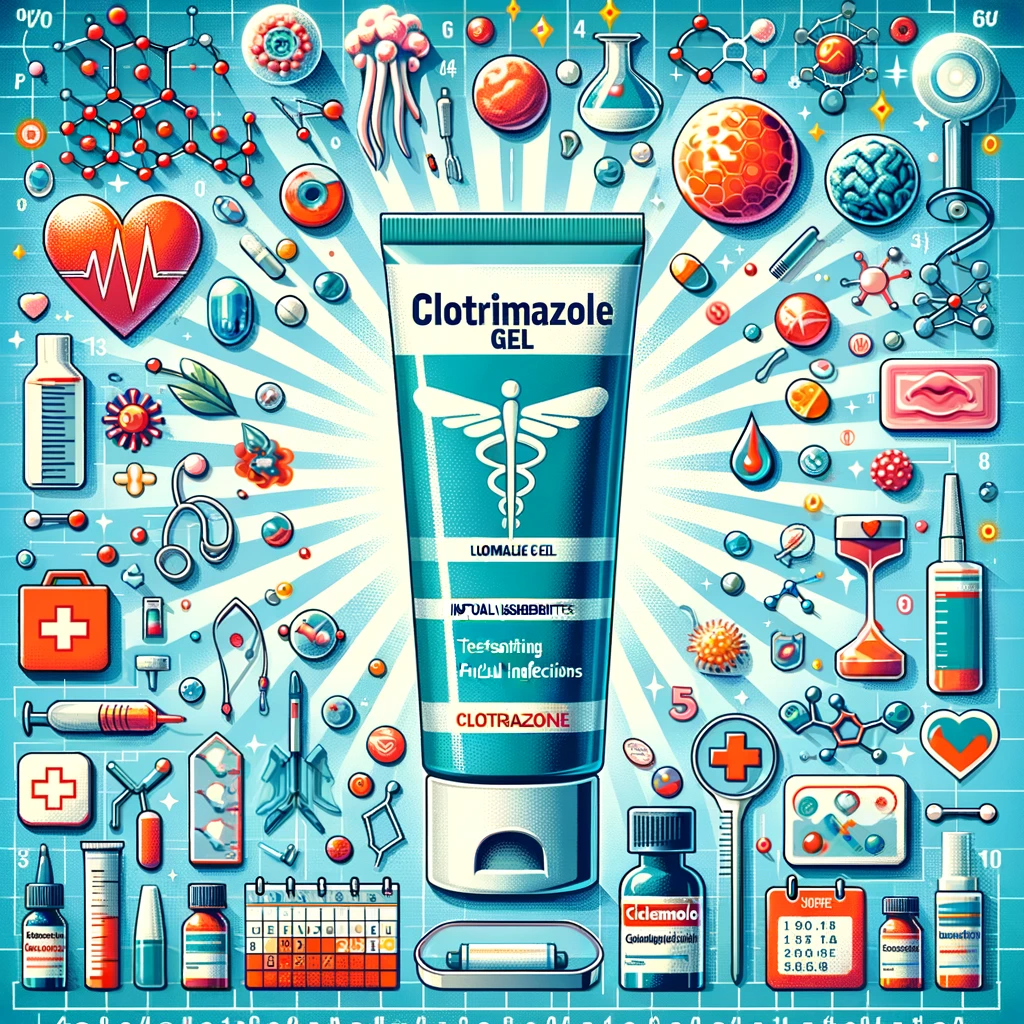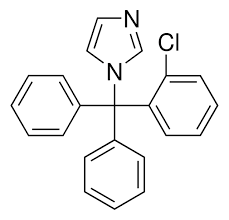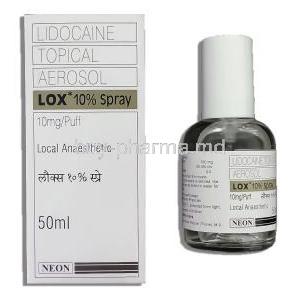Clotrimazole. Cream
- 1. Introduction
- Â
- 2. Composition
- Â
- 3. Uses
- Â
- 4. Off-label Use
- Â
- 5. How it Works
- Â
- 6. Dosage and Administration
- Â
- 7. Side Effects
- Â
- 8. Important Precautions
- Â
- 9. Interaction with Other Medications
- Â
- 10. Warnings and Contraindications
- Â
- 11. Careful Administration
- Â
- 12. Handling and Storage
- Â
- 13. Overdose Information
- Â
- 14. Handling Precautions
1. Introduction
Clotrimazole cream is an antifungal medication crucial in treating different skin conditions caused by fungal infections. Created through chemical development, this medicine has made its mark in medical history for fighting fungal diseases effectively. Its importance in treatments is significant, offering relief and healing to numerous people suffering from fungal infections.

Brief History and Development
The origin of Clotrimazole cream dates back to the mid-20th-century research efforts focused on discovering effective antifungal treatments. These investigations led to the development of Clotrimazole, which showed significant effectiveness against various fungal infections. Over time, Clotrimazole has been extensively studied in settings to confirm its safety and efficacy, solidifying its reputation as a critical component in antifungal therapy.
Importance in Antifungal Treatments
Clotrimazole cream is widely used in medicine for its versatility. Its effectiveness against a range of fungal infections makes it valuable in dermatology. The cream's ability to stop fungi from growing and ease symptoms of fungal infections highlights its crucial role in antifungal therapies.
2. Composition
The creation of Clotrimazole cream showcases the cleverness of research as it incorporates a key component blended with different additives to boost its healing capabilities.

Active Ingredients
Clotrimazole cream relies on Clotrimazole, a substance that hinders the growth of fungal cells. By targeting the cell membrane and interfering with ergosterol production, a vital element, it causes cell breakdown and ultimately eradicates the fungal organism.
Excipients and Their Roles
- Emollients are added to provide a sensation when applied, helping to moisturize the skin.
- Preservatives are included to prevent the growth of microorganisms in the cream.
- Stabilizers are used to maintain the quality of the formulation and prevent it from breaking down over time.
Formulation and Strengths
Clotrimazole cream is carefully designed to maintain the balance of effectiveness and strength, with different strengths available to address various levels of fungal infections. This allows for treatment based on each patient's specific requirements, ultimately improving the effectiveness of the therapy.
3. Uses
The versatility of clotrimazole cream is highlighted by its use in treating fungal infections, proving its effectiveness and practicality in clinical practice.
Treating Athlete’s Foot (Tinea Pedis)
Many athletes face an issue known as Athlete's Foot, but they can count on Clotrimazole cream to combat it effectively. By using this cream, they can eliminate the culprits causing the problem, improve their symptoms, and reduce the chances of it coming back.
Managing Jock Itch (Tinea Cruris)
The antifungal features of clotrimazole cream also help treat Tinea Cruris, which causes itching in the groin area. By addressing the fungi responsible, the cream relieves the itchiness and helps the skin return to its normal condition.
Treatment of Ringworm (Tinea Corporis)
Clotrimazole cream is an antifungal treatment used to help heal ringworm-infected skin and stop the infection from spreading, making it an effective solution for managing Tinea Corporis.
Applications for Oral Thrush (Candidiasis)
While initially intended for use on the skin, Clotrimazole cream has displayed potential in addressing thrush, a common form of Candidiasis. When administered accurately, it aids in eliminating Candida albicans from the membranes.
Efficacy Against Yeast Infections (Cutaneous Candidiasis)
Clotrimazole cream's effectiveness in fighting Cutaneous Candidiasis is clearly shown through its properties. By interfering with the yeast's functions, it offers a healing path to recovery, demonstrating its ability to treat yeast infections.
4. Off-label Use
The versatility of clotrimazole cream goes beyond its intended uses. It can be used to treat various skin conditions not officially approved by regulatory bodies. This off-label use practice involves addressing a range of skin issues.
- Nail Fungus Potential: Although not the primary treatment, clotrimazole cream shows promise in combating nail fungus. Its antifungal properties suggest benefits, although effectiveness may vary among individuals.
- Seborrheic Dermatitis Use: Informal evidence and initial studies suggest that the cream may help alleviate symptoms of dermatitis. The exact mechanism is not fully understood, but it could involve inhibiting specific fungi linked to the condition.
- Diaper Rash Considerations: Unconventional clotrimazole cream is sometimes used to treat diaper rash complicated by yeast infections. It offers relief by targeting the fungal overgrowth.
5. How it Works
Clotrimazole cream targets the functions of antifungal agents, focusing2 on the strength and vitality of fungal cells.
- When fighting fungi, the primary goal is to stop the production of ergosterol, an element in fungal cell membranes.
- This action disrupts the structure of the cell membrane, making it more absorbent and eventually causing the cell to break down.
- Clotrimazole affects the integrity of the cell membrane, hindering the growth and reproduction of fungi and effectively limiting the spread of infection.

6. Dosage and Administration
The effectiveness of using clotrimazole cream depends on following the prescribed dosages and application methods, which are specifically tailored to the type of fungal infection being treated.
- Different Conditions, Different Dosages: The recommended dosage varies depending on whether you're treating a mild skin infection or a stubborn nail fungus, so it's essential to customize your approach based on the severity and location of the disease.
- Applying for Best Results: To get the most out of the cream, use it to cover the infected area and its immediate surroundings. The area must be clean and dry before application.
- Treatment Duration for Success: How you use the cream can vary from a few weeks to several months. It all depends on how the infection responds to treatment and when it clears up completely.
7. Side Effects
Although generally safe, the therapeutic use of clotrimazole cream is not without side effects4. Understanding these reactions allows patients and healthcare providers to approach treatment cautiously.
- Overview of Side Effects: The range of reactions varies from mild and temporary to more severe but uncommon occurrences. This diversity highlights the need for monitoring and prompt reporting of unexpected symptoms.
- Differentiating Between Common and Rare Side Effects: The common side effects, which are mild and resolve on their own, differ from the rare side effects, which, while rare, may require immediate medical attention.

7.1 Common Side Effects
- Skin irritation and rednessre commonly mentioned side effects often appearing at the area where the medication is applied indicating a localized reaction to the treatment.
- The burning or itching feeling is noticeable, usually temporarily showing a controllable response to clotrimazole treatment.
7.2 Serious Side Effects and Allergic Reactions
Severe side effects though uncommon require an awareness of symptoms that may indicate an allergic response prompting the need for timely medical advice.
- Signs of a Severe Allergic Reaction: Symptoms like rashes, breathing difficulties, and swelling of the face, lips, tongue, or throat are indicators of severe allergic responses to clotrimazole cream.
- When to Seek Help: It is crucial to seek immediate medical attention when experiencing severe allergic reactions or if any side effects persist or worsen to ensure patient safety and treatment effectiveness.
8. Important Precautions
To use clotrimazole cream wisely, it's essential to follow precautions to ensure the treatment is safe and effective. These steps are necessary to reduce any risks of the therapy.
- Before beginning the treatment, you must provide your healthcare provider with a medical history, including any allergies or existing health conditions you may have. This initial step is necessary to customize the treatment based on your health needs.
- Regular monitoring and ongoing precautions are vital during treatment to watch for reactions. Patients should be educated on maintaining hygiene practices and avoiding covering dressings unless instructed by a healthcare professional.
9. Interaction with Other Medications
Understanding the characteristics of clotrimazole cream is crucial to grasp how it may interact with other drugs, potentially affecting the effectiveness and safety of the treatment. It's essential to note interactions with medications when using clotrimazole topically, even though its absorption into the bloodstream is minimal.
Discussing your medications with a healthcare provider is essential to prevent harmful interactions. Some drugs, those processed by the liver, could interact with clotrimazole, leading to changes in its therapeutic benefits or an increased risk of side effects. Being vigilant and maintaining communication with healthcare professionals is vital to managing these potential interactions effectively.
10. Warnings and Contraindications
Clotrimazole cream should be avoided, highlighting the importance of recognizing when it may not suit. It is recommended that individuals who are allergic to clotrimazole or any ingredients in the cream avoid using it. Moreover, applying the cream on wounds or mucous membranes is generally not recommended. Regarding health conditions and clotrimazole, extra care should be taken for patients with a history of liver disease or weakened immune systems. Healthcare providers need to carefully consider the pros and cons of using clotrimazole in a thoughtful approach to patient treatment.

11. Careful Administration
When using clotrimazole cream, it's essential to be extra cautious with groups to ensure the treatment is safe and effective.
- For patients it may be necessary to adjust dosages or monitor them closely due to their potential increased sensitivity to clotrimazoles side effects.
- Pregnant women should only use clotrimazole if necessary after weighing the risks and benefits. Nursing mothers should also be careful, as it's uncertain whether clotrimazole passes into breast milk.
- Even though clotrimazole is generally considered safe, it's essential to follow recommended dosages and guidelines based on age and weight when giving it to children.
12. Handling and Storage
Handling and storing clotrimazole cream correctly is essential to keep it working well and safe.
- To store it properly keep the cream at room temperature away from sunlight and moisture to prevent its ingredients from breaking down.
- Check the packaging for the expiration date of the cream.
- Make sure to dispose of expired products correctly to avoid using them for treatment or risk any health issues.
13. Overdose Information
While uncommon because it is typically used topically, it's essential to recognize the symptoms of too much clotrimazole and know what steps to take immediately.
- Signs of Overdose: Using much can result in more potent side effects, like severe irritation or allergic reactions.
- Immediate Steps and Treatment: If you suspect an overdose, stop using the product and seek help right away to prevent any possible harmful effects.
14. Handling Precautions
Following safety measures when using clotrimazole cream is crucial to ensure its practical application. Remember to wash your hands after applying the cream to avoid any contamination.









































